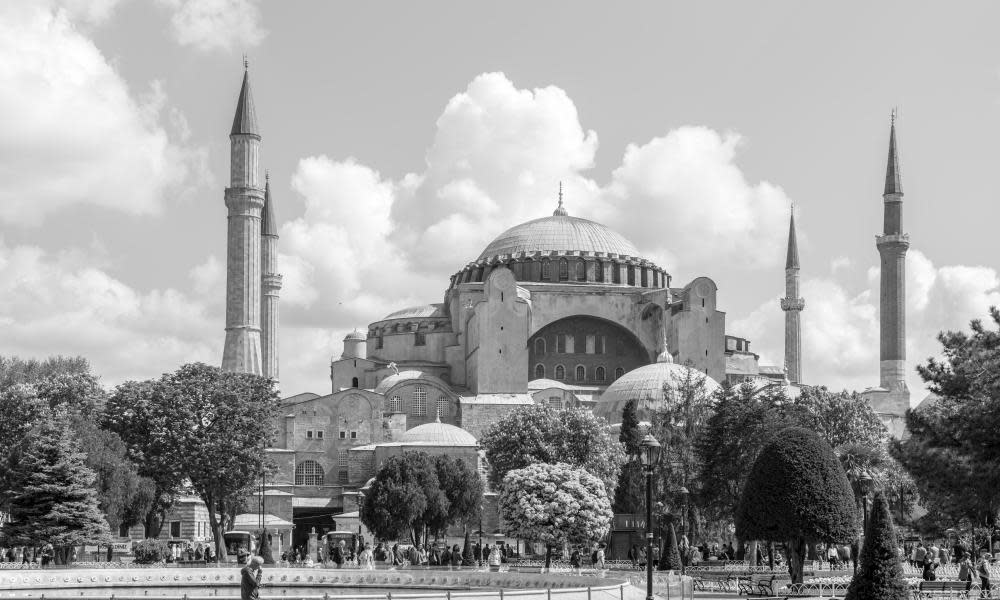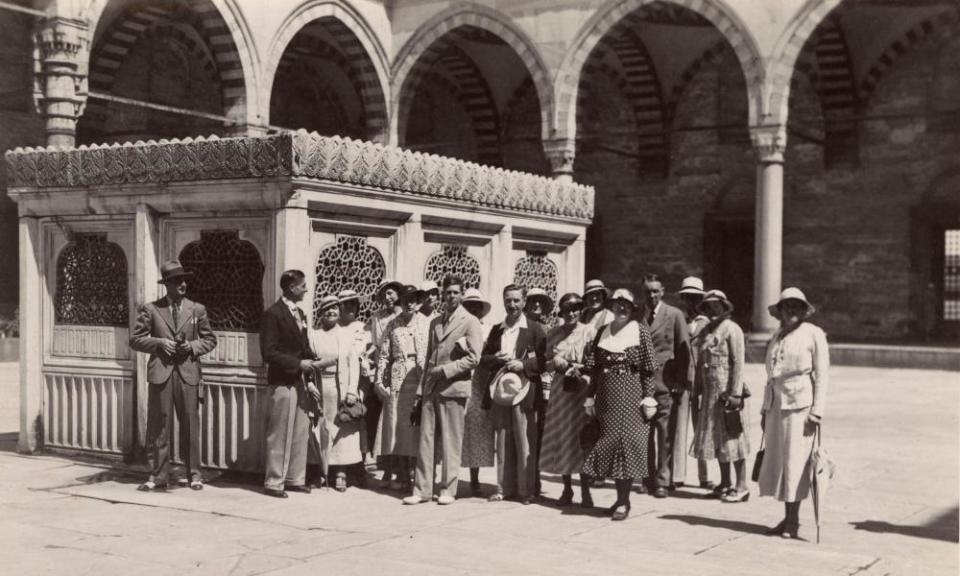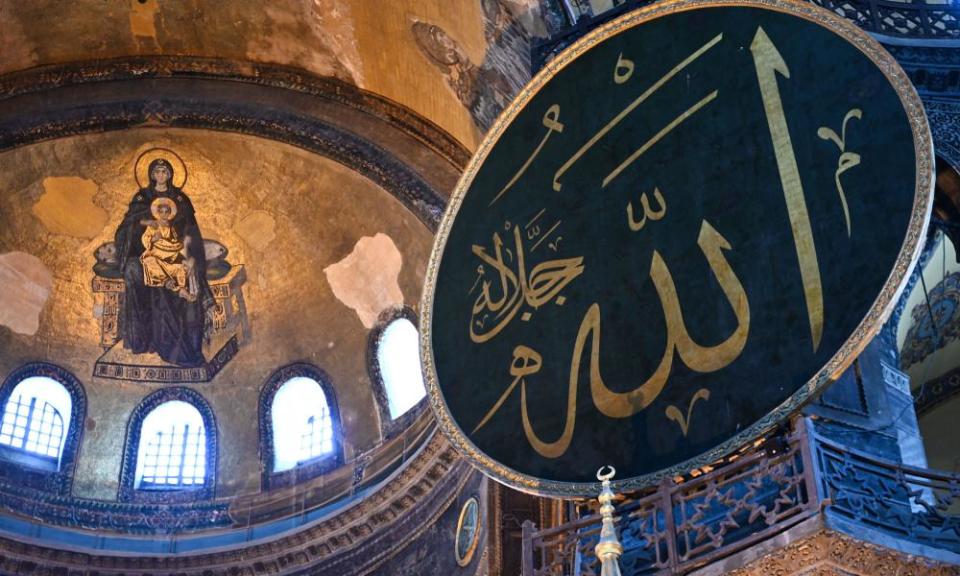Hagia Sophia's conversion into a museum - archive, 1935

Saint Sophia: conversion into a museum
New discoveries – a Christian mosaic of 1,000 years ago
12 June 1935
The Turks have carried out another quiet revolution. They have become preservers of Christian art. They have abandoned the use of Saint Sophia as a mosque. Saint Sophia, whose dedication to Moslem worship was for a long the very symbol of their dominance at Constantinople. For nine hundred years the greatest cathedral of imperial Eastern Rome, for four hundred and eighty years the greatest or, at any rate, the most famous Turkish mosque, for all time the greatest triumph of large-scale Byzantine building, it has tranquilly slipped into the state of a rather empty museum.
An unexpected fate, marking new times. The whole of the nineteenth century saw it a symbolic centre of the rival political ambitions of Holy Russia; and then of imperial-minded Greece, and then of Allied Western Christendom. To put the Cross instead of the Crescent above its dome was an idea that ruled chancelleries and filled the correspondence columns of the newspapers. But it has not been done. Worship will never he renewed in the church. It is now a Byzantine museum.
Related: Hagia Sophia: the mosque-turned-museum at the heart of an ideological battle
Only a little time ago black-soutaned hodjas (priests) came out of their cubby-hole when you reached the door and bent to put you into the great shabby black slippers in which you were bound to enter, clean, the holy ground. Their white turbans round the hardly seen brown fez were almost the only reminder of the East that you had come upon in the new Istanbul. You were thrilled a little. To-day a polite official in everyday dress leans over a smart deal table, just where the hodjas were, and takes your stick or your umbrella and your ten-piastre fee. You are not thrilled at all.
Ancient worship
Then, too, a few months ago only, you could stumble on the magic of the ancient worship, feebly retained perhaps but always bringing you on to a new level of emotion. In the huge carpeted expanse, dim in the distance under the dome, there were rows of worshippers sitting back on their ankles, bowing prostrate till their foreheads touched the ground at the lead of the cleric in the niche which still pointed them to Mecca and the Black Stone. As you approached slowly, some stocking-footed figure carrying his boots would run in past you and take his place in the praying rank. The wailing plaint of the singing cleric rose and spent itself in the dome and the great spaces. Just one voice only, just one phrase only, then silence till another rose and broke the tranquillity.
And, there in the south aisle, if one can talk of an aisle in this splendidly arcaded building, with its purple columns a hundred feet high, you could find a little congregation of forty or fifty men sitting on the floor within a railed-off space while the teaching hodja read them the Koran and made comments. They followed his eloquence with the theological avidity of old-world Scotsmen. Older faces these mostly, and of the poorer class, but as devout as ever.

Somehow one was glad of worship in a place made for worship. It is all over now. It ended without a word being spoken. One day it was found that the gates of the courtyard leading to the shrine were closed. An ill-written notice in ink on crooked slabs of cardboard told the visitor, in the capital letters of the new Latin-charactered Turkish, “Closed for cleaning and turning into a museum.” Its little band of clerics and servers had simply been bundled out and given posts in other mosques of the city. If they had murmured at all they had done it in their beards. There was not a single audible voice of protest.
Door of the first church
Then came the antiquity searchers and all the ticketing and altering personnel of a museum. German archaeologists from Berlin under Dr Schedel began driving trenches in the courtyard at the western end and hauling about with primitive chain cranes the big blocks of carved marble which they soon dug up below. It was not long before they made a find – the west entrance door of the first Saint Sophia, the church of Constantine the Great, founder of Constantinople, which was burnt down. It was a little farther west than the west entrance door of Justinian’s church. There lying by it was still the carved architrave which topped it. On the marble blocks appeared the Christian symbols – the lamb, the vine-leaf, the doves. And the carving is delicate and but slightly damaged by earthquake and fire. To the doorway there runs a marble approach road, several lengths of which have been uncovered.
Soon the work will be finished there. The trenches will be filled up. Perhaps the ancient doorway will be raised in place. The rest of the marble blocks will be stacked about the courtyard, the very first relics of the Byzantine church building. But the ground is not very firm. It would not bear, without sinking, the huge porphyry sarcophagi which gave last, housing to so many Byzantine emperors and which are to be removed from the outdoor part of the Antiquity Museum, where they now lie in purple neglect, and put there. So the trench-driving is to be followed by the making of concrete emplacements for the imperial tombs and for the other heavy objects which throw light on Byzantine art
Meanwhile inside the removers were busy. The prayer mats were swept away and taken to Adrianople to the Sultan Selim mosque there, one of wonders of Turkish architecture. The marble flooring, irregular with age, was revealed, and in one place, a little towards the south-east end of the nave before you are under the dome, there appeared to the cleaners a six-foot square of coloured marble inlay work, giving a large mosaic effect. The rinsers brought out its hues, and one wonders why exactly there should have been this little bit of picture floor.

Mosaic pictures
The next thing was to take down the four huge green wooden circular shields, ten yards in diameter, from the pier tops under the dome, where they bore in gold Arabic lettering and exquisite calligraphy the names of the prophet and his successors. For nearly five centuries their discordant green had shouted across at the dimming colours of the splendid marbles with which the walls are covered. When they were got down, it was found that they could not be passed. through the doors. So – and also because this museum of Byzantine art is to house Ottoman objects of interest to this building too – they are stacked one against another against an aisle wall, and you can touch the gold names.
Thus has the museum been prepared. But meanwhile, the ex-cathedral ex-mosque has itself been turned into the chief art object which it will exhibit. Professor Whittemore, of the Boston Byzantine Institute, has been working in it quietly for two and a half years. He has completed the inner hundred-yard-long porch, revealing and resetting its mosaic crosses, on long concealed under plaster, and its still more important mosaic pictures.
The latest and the finest of these mosaics he opened just lately. It immediately confronts everyone who enters the building. It is in a semicircular space above the second south inner door by which the porch is approached. It is low down and easy to see. A tenth-century piece, it is the best example of Christian mosaic work revealed in Constantinople yet, and surpasses in beauty and perfect preservation the mosaic pictures of the Kahrié and the Fethié mosques here. It shows the Virgin seated on a golden throne holding the Child, a delightful full-grown boy, while on either side of her stand life-size figures of Constantine offering her a sea-walled Constantinople, the new Rome, and Justinian offering her, with an equally charming bow of the head, the cathedral of Saint Sophia, which he never thought would be a museum.
Related: Erdoğan leads first prayers at Hagia Sophia museum reverted to mosque
In August 1980, the Sultan’s Lodge, a Hagia Sophia annex, opened once again for Islamic prayers.
Islamic services to return to Istanbul’s ‘cathedral’
by David Barehard in Ankara
19 July 1980
After a lapse of half a century, Islamic religious services are to be held once more in the former Byzantine cathedral of St Sophia in Istanbul. St Sophia, built in the 6th century by the Emperor Justinian, and acclaimed as one of the world’s greatest architectural masterpieces was turned into a museum by Kemal Ataturk in 1930.
Clerical Muslim opinion in Turkey, however, has long pressed for the building to be reopened as mosque. It was converted into a mosque by Sultan Mahomet the Conqueror in 1453 after the Turkish conquest of Constantinople.
Ataturk’s decision to convert St Sophia into a museum made it possible for archaeologists and art experts to uncover some of the greatest masterpieces of Byzantine mosaic work which had been buried for almost half a millennium behind plaster. The Turkish Ministry of Culture insists that these and other works of art in the building will not be affected by its decision to permit religious services to be held in part of the basilica next month.
For defenders of the secularist traditions of Ataturk, however, the Government’s decision has come as a considerable shock. It is being cited as yet another example of the growing influence in Turkey of extreme right-wing Muslim groups.
Church reopens
9 August 1980
Muslims prayed in Istanbul’s Church of St Sophia for the first in in 45 years yesterday, after it was reopened for worship. The church was, built but the Emperor Justinian, was converted into a mosque in 1453, and a made into a museum in 1935.

 Yahoo News
Yahoo News 
